
Concept explainers
(a)
Interpretation: The organic product that is formed in the given reaction is to be determined.
Concept introduction: The various organic reactions form different organic products with the help of the variety of reagents. Some of the organic compounds are formed by the characteristic action of the various
Answer to Problem 29.64P
The organic product of the given reaction is,
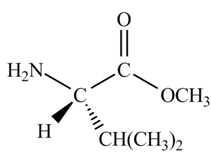
Explanation of Solution
The product formed by the reaction of the given amino acid compound with methanol in the presence of an acid is shown as,

Figure 1
On reaction of carboxylic acid group of this amino acid compound with methanol and acid, methyl ester group is placed at the carboxylic group site to form the desired product.
The organic product of the given reaction is shown in Figure 1.
(b)
Interpretation: The organic product that is formed in the given reaction is to be determined.
Concept introduction: The various organic reactions form different organic products with the help of the variety of reagents. Some of the organic compounds are formed by the characteristic action of the various functional groups present in them.
Answer to Problem 29.64P
The organic product of the given reaction is,
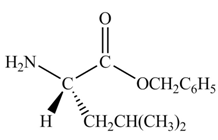
Explanation of Solution
The product formed by the reaction of the given amino acid compound with benzyl alcohol in the presence of an acid is shown as,

Figure 2
On reaction of carboxylic acid group of this amino acid compound with benzyl alcohol and acid, benzyl ester group is placed at the carboxylic group site to form the desired product.
The organic product of the given reaction is shown in Figure 2.
(c)
Interpretation: The organic product that is formed in the given reaction is to be determined.
Concept introduction: The various organic reactions form different organic products with the help of the variety of reagents. Some of the organic compounds are formed by the characteristic action of the various functional groups present in them.
Answer to Problem 29.64P
The organic product of the given reaction is,

Explanation of Solution
The product formed by the reaction of the given amino acid compound with

Figure 3
On reaction of amino group of this amino acid compound with
The organic product of the given reaction is shown in Figure 3.
(d)
Interpretation: The organic product that is formed in the given reaction is to be determined.
Concept introduction: The various organic reactions form different organic products with the help of the variety of reagents. Some of the organic compounds are formed by the characteristic action of the various functional groups present in them.
Answer to Problem 29.64P
The organic product of the given reaction is,
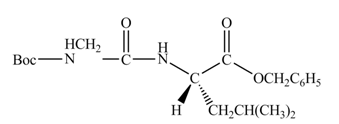
Explanation of Solution
The product formed by the reaction of product formed in (b) with the product formed in (c) in the presence of DCC is shown as,
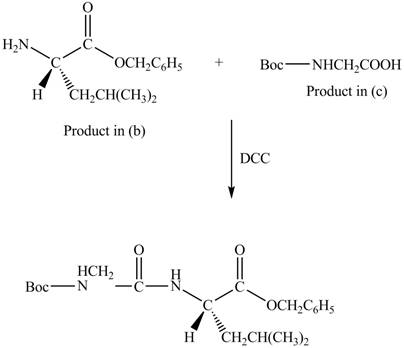
Figure 4
The carboxylic group gets activated by the DCC for the nucleophilic attack which prepare
The organic product of the given reaction is shown in Figure 4.
(e)
Interpretation: The organic product that is formed in the given reaction is to be determined.
Concept introduction: The various organic reactions form different organic products with the help of the variety of reagents. Some of the organic compounds are formed by the characteristic action of the various functional groups present in them.
Answer to Problem 29.64P
The organic product of the given reaction is,
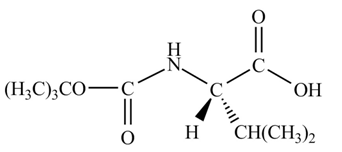
Explanation of Solution
The product formed by the reaction of amide compound with

Figure 5
The reaction of amide compound with
The organic product of the given reaction is shown in Figure 5.
(f)
Interpretation: The organic product that is formed in the given reaction is to be determined.
Concept introduction: The various organic reactions form different organic products with the help of the variety of reagents. Some of the organic compounds are formed by the characteristic action of the various functional groups present in them.
Answer to Problem 29.64P
The organic product of the given reaction is,

Explanation of Solution
The product formed by the reaction of amide compound with

Figure 6
The reaction of amide compound with
The organic product of the given reaction is shown in Figure 6.
(g)
Interpretation: The organic product that is formed in the given reaction is to be determined.
Concept introduction: The various organic reactions form different organic products with the help of the variety of reagents. Some of the organic compounds are formed by the characteristic action of the various functional groups present in them.
Answer to Problem 29.64P
The organic product of the given reaction is,

Explanation of Solution
The product formed by the reaction of product formed in (e) with

Figure 7
The reaction of amide compound with
The organic product of the given reaction is shown in Figure 7.
(h)
Interpretation: The organic product that is formed in the given reaction is to be determined.
Concept introduction: The various organic reactions form different organic products with the help of the variety of reagents. Some of the organic compounds are formed by the characteristic action of the various functional groups present in them.
Answer to Problem 29.64P
The organic product of the given reaction is,

Explanation of Solution
The product formed by the reaction of amino acid compound with
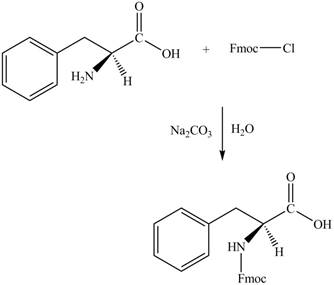
Figure 8
The reaction of amino acid compound with
The organic product of the given reaction is shown in Figure 8.
Want to see more full solutions like this?
Chapter 29 Solutions
Organic Chemistry
- #20 B Draw structural formulas for all possible carbocations formed by the reaction of each alkene with HCl.arrow_forwardDraw the products formed when (CH3)2C=CH2 is treated with each reagent.a. HBrb. H2OH2SO4c. CH3CH2OH, H2SO4d. Cl2e. Br2, H2Of. NBS (aqueous DMSO)g. [1]BH3;[2]H2O2, HO-arrow_forwardCH2 = CH2 + Br+ CH2-CH2Br This is a step in a ____ reaction where ____ is the electrophilearrow_forward
 Organic Chemistry: A Guided InquiryChemistryISBN:9780618974122Author:Andrei StraumanisPublisher:Cengage Learning
Organic Chemistry: A Guided InquiryChemistryISBN:9780618974122Author:Andrei StraumanisPublisher:Cengage Learning
